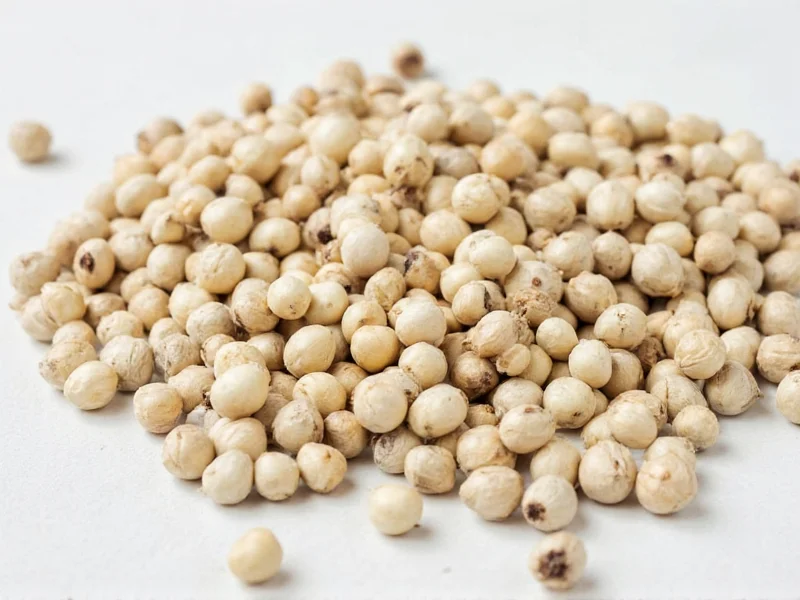Understanding what white pepper is requires examining its botanical origins and processing methods. Both white and black pepper come from the same flowering vine native to South Asia, but their production processes create distinct flavor profiles and culinary applications. White pepper's unique characteristics make it valuable in specific cooking scenarios where a milder heat and less visually prominent spice are desired.
Botanical Origins and Production Process
White pepper begins as fully ripe berries from the Piper nigrum plant, the same source for black, green, and red pepper varieties. The critical difference lies in processing: after harvesting ripe berries, producers soak them in water for about a week, allowing enzymatic fermentation that loosens the outer fruit layer (the pericarp). Workers then rub off this outer layer, leaving behind the pale seed that becomes white pepper after sun-drying.
This labor-intensive process explains why white pepper often costs more than black pepper. The soaking and rubbing steps require careful handling to prevent mold development while ensuring complete removal of the fruit layer. Major production regions include Vietnam, Indonesia, and Malaysia, where tropical conditions support Piper nigrum cultivation.
Flavor Profile Comparison
When exploring what is white pepper in terms of taste, several key differences emerge compared to black pepper:
| Characteristic | White Pepper | Black Pepper |
|---|---|---|
| Heat Level | Milder, more subtle heat | Sharper, more pronounced heat |
| Flavor Notes | Earthy, musty, slightly fermented | Pungent, floral, citrus undertones |
| Aroma | Less intense, more delicate | Stronger, more complex |
| Aftertaste | Cleaner, shorter finish | Longer-lasting warmth |
The difference between white pepper and black pepper taste primarily stems from the removal of the outer layer, which contains many volatile oils responsible for black pepper's characteristic aroma and sharper heat. This makes white pepper particularly valuable in light-colored dishes where black specks would be visually disruptive.
Culinary Applications and Usage Tips
Chefs often choose white pepper instead of black pepper for specific applications. Traditional French and Chinese cuisines frequently feature white pepper in creamy sauces, mashed potatoes, light-colored soups, and seafood dishes where visual presentation matters. Many commercial potato salad recipes specify white pepper to maintain a uniform appearance.
When using white pepper in cooking, consider these guidelines:
- Add toward the end of cooking to preserve its more delicate flavor
- Use in dishes with subtle flavors that might be overwhelmed by black pepper
- Grind fresh for maximum flavor impact, as pre-ground white pepper loses potency faster than black
- Start with smaller amounts than black pepper, then adjust to taste
Some professional kitchens maintain both varieties, selecting based on the specific dish requirements. Understanding when to use white pepper instead of black pepper demonstrates culinary sophistication and attention to detail.
Nutritional Content and Potential Benefits
White pepper nutritional facts show it contains similar compounds to black pepper, though in slightly different proportions due to the processing method. Both contain piperine, the compound responsible for pepper's heat and potential health benefits. A single teaspoon (about 2 grams) provides minimal calories but contains:
- Trace amounts of manganese, iron, and vitamin K
- Antioxidants including piperine and other phytochemicals
- Dietary fiber
Research suggests piperine may enhance nutrient absorption, particularly of curcumin in turmeric. While white pepper health benefits haven't been studied as extensively as black pepper, the shared active compounds suggest similar potential properties, including anti-inflammatory effects and digestive support.
Selection, Storage, and Shelf Life
When selecting white pepper, look for uniform pale color without dark spots, which indicate incomplete processing or moisture exposure. Whole peppercorns maintain freshness significantly longer than pre-ground versions. For optimal flavor preservation:
- Store in an airtight container away from light and moisture
- Keep in a cool, dark pantry location (not above the stove)
- Use within 1-2 years for whole peppercorns, 6-12 months for ground
White pepper's more delicate compounds make it particularly susceptible to flavor degradation. Many culinary professionals recommend buying smaller quantities more frequently compared to black pepper. Properly stored, high-quality white pepper should have a clean, earthy aroma without mustiness or staleness.
Common Misconceptions
Several myths surround white pepper that deserve clarification. Contrary to popular belief, white pepper isn't milder because it's "less mature" than black pepper—it actually comes from riper berries. The misconception that white pepper is "just black pepper with the skin removed" oversimplifies the fermentation process essential to proper white pepper production.
Another common question is whether white pepper and black pepper come from different plants—they don't. Both originate from Piper nigrum, with processing differences creating the distinct varieties. Understanding where does white pepper come from helps dispel these persistent myths.











 浙公网安备
33010002000092号
浙公网安备
33010002000092号 浙B2-20120091-4
浙B2-20120091-4